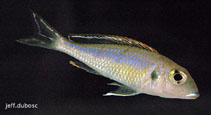| Family: |
Cichlidae (Cichlids), subfamily: Pseudocrenilabrinae |
| Max. size: |
10 cm TL (male/unsexed) |
| Environment: |
benthopelagic; freshwater; pH range: 7 - 8.5; dH range: 10 - 15 |
| Distribution: |
Africa: Endemic to Lake Tanganyika, except the south end of the Lake (Ref. 35977). |
| Diagnosis: |
Dorsal spines (total): 12-14; Dorsal soft rays (total): 11-14; Anal spines: 3-3; Anal soft rays: 7-9; Vertebrae: 30-32. Body slightly elongated, highest at origin of dorsal fin; dorsal profile gently rounded, ventral profile rather straight (Ref. 35977). Mouth very low; jaws usually equal; maxillary may or may not extend to a vertical line through anterior margin of eye (Ref. 35977). All teeth on both jaws conical, recurved, arranged in outer and inner series (Ref. 35977). First dorsal spine very short, all spines with a lappet near tip; all dorsal fin soft rays usually branched (Ref. 35977). First anal spine very short, length of subsequent spines increasing progressively, and all spines with a small lappet near tip (Ref. 35977). Pectoral fin reaching between anus and third anal fin spine (Ref. 35977). Pelvic fin filamentous, reaching between anus and second anal fin spine (Ref. 35977). Scales ctenoid on lateral surface of body (Ref. 35977). |
| Biology: |
Occurs over sand bottoms near rocks where they feed on invertebrates. Forms schools. Bury themselves in the sand to evade predators (Ref. 6770). |
| IUCN Red List Status: |
Least Concern (LC); Date assessed: 31 January 2006 Ref. (130435)
|
| Threat to humans: |
harmless |
Source and more info: www.fishbase.org. For personal, classroom, and other internal use only. Not for publication.
